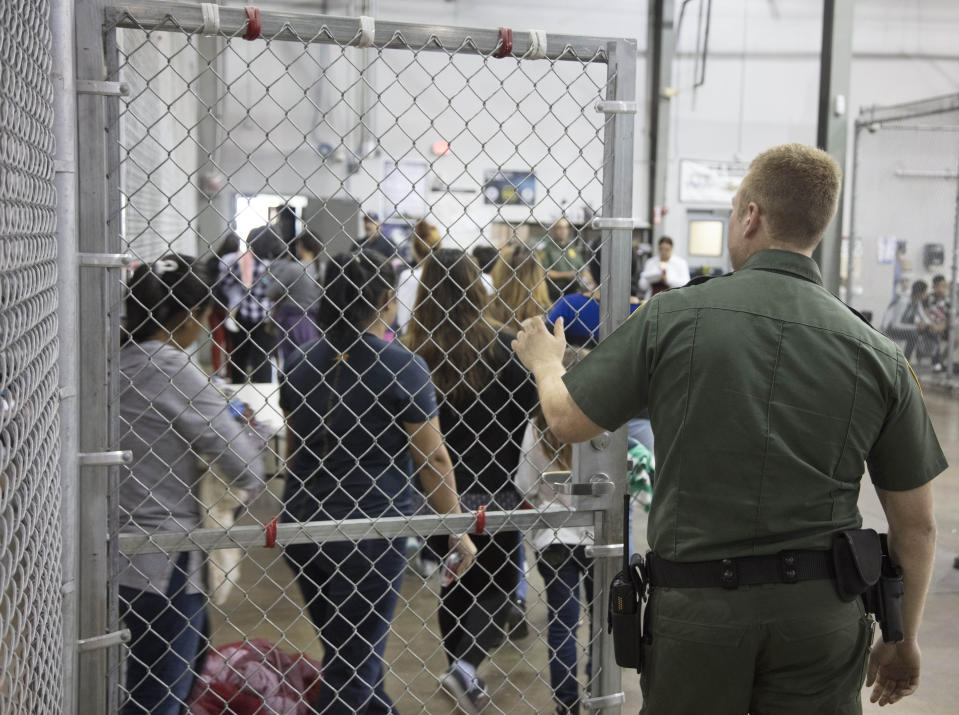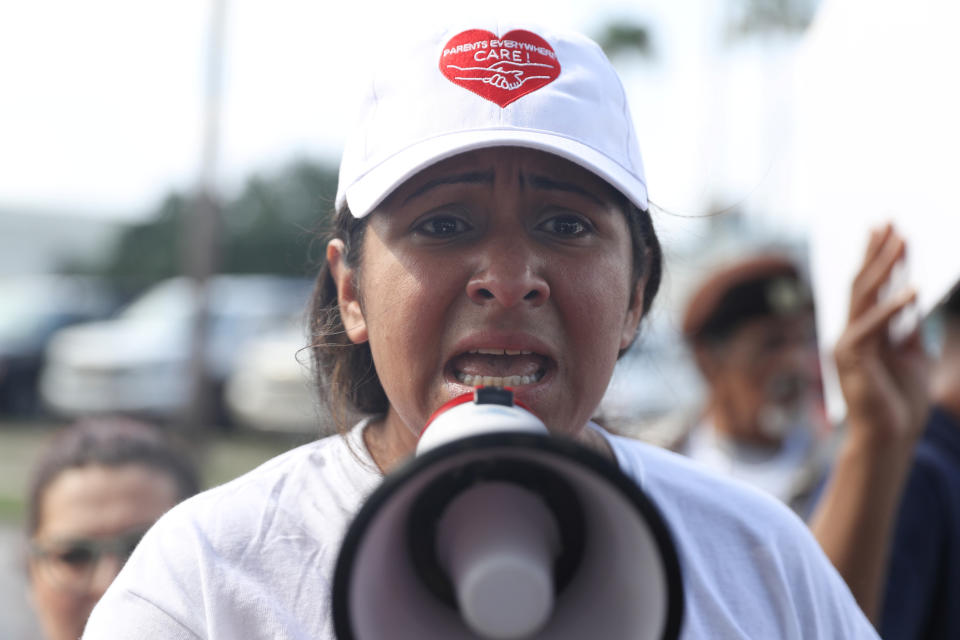'Imagine your own children there': Grim reports mount from border detention camps
As more reports surfaced of inhumane conditions at the government’s migrant detention facilities, the movement to label them “concentration camps” picked up steam with backing from a major newspaper.
Dolly Lucio Sevier, a physician, and a group of lawyers visited border facilities in two Texas cities: McAllen and Clint. In an assessment obtained by ABC News, Lucio Sevier wrote that “the conditions within which they are held could be compared to torture facilities.” Lucio Sevier was granted access after lawyers expressed concern about a flu outbreak in the McAllen facility.

Lucio Sevier described the conditions as “extreme cold temperatures, lights on 24 hours a day, no adequate access to medical care, basic sanitation, water, or adequate food” and added that teens there said they had no access to hand-washing. Mothers of infants said the camps lacked facilities for washing bottles. Lucio Sevier said the conditions were “tantamount to intentionally causing the spread of disease.”
“It just felt, you know, lawless,” Lucio Sevier said in an interview with ABC News. “I mean, imagine your own children there. I can’t imagine my child being there and not being broken.”
On Monday, Rep. Veronica Escobar — who represents the El Paso, Texas, area — said that the government had moved most of the children from the Clint facility. It is unclear where they were moved.
President Trump has claimed he is simply continuing the policy of separating families begun by former President Barack Obama, but that is untrue. The Obama administration did occasionally split families but did not have a blanket policy to do so. The default separations began with the declaration of a “zero tolerance” policy in April 2018, under which any migrant who crossed the border illegally would be referred to criminal prosecution.
In interviews with CNN and NPR, former secretary of Homeland Security and White House chief of staff John Kelly said he was considering family separation as a “deterrent” to migration and that children would be taken care of by “being put into foster care or whatever.”
Many of the migrants are fleeing danger in their home countries in Central America and claiming asylum in the United States, as provided under both international and U.S. law.

Lucio Sevier’s report is the latest horror story from the detainment facilities. Last week the Associated Press reported that immigration attorneys said younger children in a border facility were being left in the care of older children, including a 4-year-old in the care of an 8-year-old.
“In my 22 years of doing visits with children in detention, I have never heard of this level of inhumanity,” said Holly Cooper, who co-directs University of California, Davis’s Immigration Law Clinic and represents detained youth, in an interview with the AP.
Warren Binford, one of the lawyers who visited the Clint facility last week, told the New Yorker that there were approximately 350 children at a facility built to hold 104. Many of the children being kept there told Binford that they had barely showered or been able to brush their teeth.
“They are worse than actual prison conditions,” said Binford in an interview with NPR. “It is inhumane. It's nothing that I ever imagined seeing in the United States of America. And that’s why we have gone to the press. We never go to the media about our site visits. And after the second day of interviewing these children, you know, we called up the attorneys who are in charge of this case. And because of the extreme conditions that we saw there, we were given permission to speak to the media because children are dying on the border in these stations.”
Last week HuffPost reported that four children at the McAllen facility were so sick that lawyers demanded they be hospitalized. Per their report:
The children, all under age 3 with teenage mothers or guardians, were feverish, coughing, vomiting and had diarrhea, immigration attorneys told HuffPost on Friday. Some of the toddlers and infants were refusing to eat or drink. One 2-year-old’s eyes were rolled back in her head, and she was “completely unresponsive” and limp, according to Toby Gialluca, a Florida-based attorney.
Human Rights Watch reported in February 2018 on what they called “abusive conditions” for women and children in U.S. Customs and Border Protection. The HRW document from February included concerns similar to those documented in many of the more recent reports: sleeping on the floor in freezing cells with limited blankets and a lack of access to soap, toothpaste or toothbrushes. A Department of Homeland Security inspection found “egregious violations of detention standards,” including expired food and nooses found in cells and bathrooms that were “dilapidated and moldy.” The DHS has also warned of “dangerous overcrowding,” including “detainees standing on toilets in the cells to make room and gain breathing space, thus limiting access to the toilets.”
Per NBC News, at least seven children have died in immigration custody over the last year.
Acting Customs and Border Protection commissioner John Sanders acknowledged in an interview with the AP that children needed better medical care, and urged Congress to pass an emergency funding package that would include $3 billion in funding to care for unaccompanied children. Trump and Vice President Mike Pence have blamed Congress for the conditions.
Per Sanders, the agency considers 4,000 to be capacity, and they are currently holding 15,000 people.
Justice Department lawyer Sarah Fabian argued last week in front of the U.S. Court of Appeals that toothbrushes, soap and blankets “may be” part of the definition of “safe and sanitary” as laid out by the 1997 Flores Settlement, which dictates the treatment of migrant children.
The reported horrific conditions at the facilities have led to a war over the semantics of what to call the facilities. Rep. Alexandria Ocasio-Cortez was among those criticized for referring to the detention facilities as concentration camps, a term that has a technical meaning but is sometimes conflated with Nazi extermination camps.
“For the shrieking Republicans who don’t know the difference: concentration camps are not the same as death camps,” Ocasio-Cortez wrote on Twitter. “Concentration camps are considered by experts as ‘the mass detention of civilians without trial.’ And that’s exactly what this administration is doing.”

Experts agreed.
“We have what I would call a concentration camp system,” Andrea Pitzer, author of “One Long Night: A Global History of Concentration Camps,” told Esquire.
“What’s required is a little bit of demystification of it,” says Waitman Wade Beorn, a Holocaust and genocide studies historian at the University of Virginia, in the same article. “Things can be concentration camps without being Dachau or Auschwitz. Concentration camps in general have always been designed — at the most basic level — to separate one group of people from another group. Usually, because the majority group, or the creators of the camp, deem the people they’re putting in it to be dangerous or undesirable in some way.”
On Sunday, the Salt Lake Tribune weighed in via its editorial page, concurring with the assessment that the facilities were concentration camps.
“Yes, we do have concentration camps,” stated the paper’s editorial board. “They are not work camps. They are not death camps. At least, not on purpose. Our government is not building massive gas chambers and industrial crematoria. It is not conducting sick medical experiments on members of an unfavored class. But that does not mean that the places into which we are herding tens of thousands of migrants, refugees and asylum-seekers are not properly called concentration camps. Because that is precisely what they are.”
Concentration camps predate Nazi Germany and were employed by Spanish colonial officials in Cuba during the war for independence in the late 19th century and by the British in South Africa during the turn-of-the-century Boer War. The United States housed Japanese-Americans, including American-born citizens, in camps around the West after the attack on Pearl Harbor.
Ocasio-Cortez noted that just last week, the U.S. Department of Health and Human Services announced that Fort Sill, an Army base in Oklahoma that was used to intern Japanese-Americans during World War II, will be used to detain as many as 1,400 children until they can be turned over to an adult relative.
Read more from Yahoo News:



